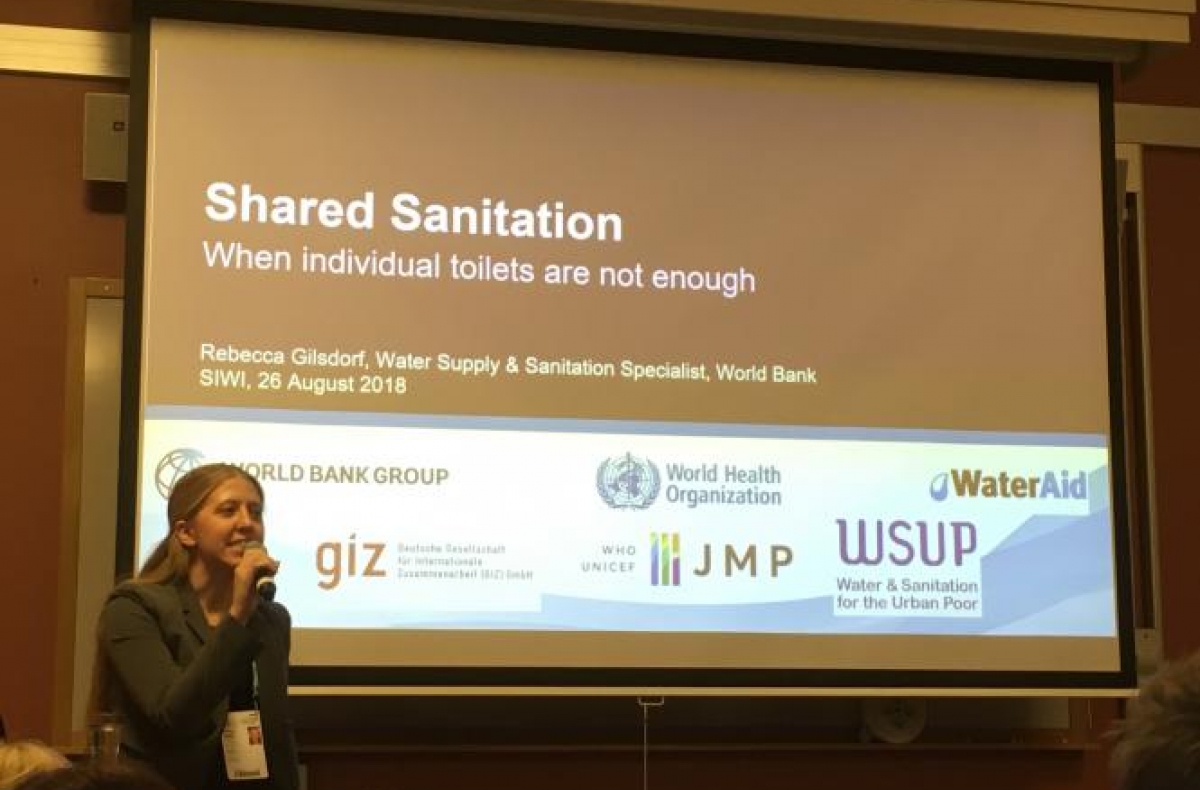Thinking though shared sanitation
WHD researcher launches World Bank report to help decision makers think through complex shared sanitation-related decisions on issues such as payment and maintenance models, regulation, and community preferences.
October 17, 2018

A solution isn’t a solution if it stops working. Taking that message to heart, Rebecca Gilsdorf works with international funders, government ministers and others to ensure shared sanitation facilities serve communities that desperately need them.
Gilsdorf is simultaneously pursuing a Ph.D. in civil and environmental engineering at Stanford – focused on urban and peri-urban water supply and wastewater treatment / reuse in East Africa – while working in the World Bank’s prestigious Young Professionals Program. Based in the bank’s Washington, D.C. headquarters, Gilsdorf works with a team of experts on urban sanitation and related issues of citizen engagement, gender and inclusion primarily in Ghana, Ethiopia, Morocco, Egypt and Angola.
At World Water Week in Stockholm this past August, Gilsdorf presided over the launch of a new World Bank report featuring new data, analyses, case studies and practical guidance intended to help decision makers think through complex shared sanitation-related decisions on issues such as payment and maintenance models, regulation, and community preferences. Among the major takeaways: an experimental mindset and an appetite for taking risks in design, implementation, and management are key to the success of shared toilet models.
“The first message is that you have to plan from the beginning for operation and maintenance,” says Gilsdorf. “While it gets less attention than announcing new builds or new initiatives, operation and maintenance are incredibly important. It’s much more cost-effective to fix existing facilities than build new ones. So, it’s shocking how many toilets at schools, hospitals and markets are nonfunctional.”
While individual household sanitation is both crucial and aspirational, it will be insufficient to meet the needs of growing urban populations in the coming years, according to Gilsdorf. In urban areas, almost one person in ten uses a toilet shared with at least one neighboring household. The WASH sector emphasizes individual household toilets, as evidenced by investment programs and what counts as ‘success’ in expanding sanitation service. This does a disservice to the tens of millions of people living in urban areas who will not have toilets in their homes in the foreseeable future, Gilsdorf writes in a World Bank blog post. It also draws attention away from the fact that millions of people spend much of each day away from home, often in schools and workplaces lacking safe, clean sanitation facilities.
Anecdotal and empirical evidence suggest that many shared and public toilets fail within a few years of installation, largely the result of poor operations and maintenance. To change that narrative, Gilsdorf focuses on ways to overcome barriers to safe, clean shared toilets and related service systems, such as challenging geographical terrain and population density. An inclusive engagement process among operators, regulators and a range of users is essential to striking a balance of compromises on what’s technically, politically and financially possible.
“It’s not one simple answer,” Gilsdorf says.
In addition to engaging multiple stakeholders, decision makers planning shared sanitation would do well to have an experimental, risk-taking mindset, according to Gilsdorf. As an example, she mentioned Addis Ababa, Ethiopia, where small businesses run shared toilet facilities around the city. At one facility, the wheelchair-bound operator could not make use of the toilets herself because of stairs. City leaders took the operators’ feedback to heart and began work to make all new public toilets accessible to disabled users. Other feedback led to the construction of backup water tanks (to ensure continued service when the water supply network is down) and laundry/washing stations. Some facilities even sell coffee in their sitting areas.
“They’ve turned them into much more user-friendly spaces. They are much more marketable spaces for the operators,” Gilsdorf says. “Being willing to change as you go is a risk. But it’s only by innovating and learning that solutions will be adapted to provide service to everyone.”
Read Gilsdorf’s introduction to shared sanitation.
Read more about the World Bank’s work on Citywide Inclusive Sanitation
Contact Information
Rob Jordan
Associate Editor, Environment and Sustainability, Woods Institute
rjordan@stanford.edu


